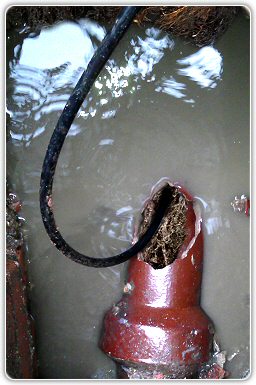You Are Here  Home
Home  High-Pressure Water Jetting
High-Pressure Water Jetting  Root Removal
Root Removal


Root Removal
Do you have trees around your property? Are they established trees? Perhaps positioned close to an existing drainage system?
If that's a "yes", then depending on the depth of the drainage in question and the root system of the tree(s), chances are you have some degree of root infiltration within your drainage system.
Left long enough, as well as causing sporadic, and often repeat blockages, root infiltration can cause serious damage to your system.
Using a root cutting tool, in conjunction with a high-pressure water jetting machine, root infestations can be cleanly sliced and removed from the drainage system.

Reasons for Root Cutting
Root cutting is often performed as a pre-curser to remedial or renovation works.
Depending on the circumstances, root cutting may be required as part of an on-going maintenance contract to keep the system flowing. However, this is generally seen as a short-term solution.
Work undertaken to remove roots can generally only be carried out from available access points such as manholes and/or inspection chambers.
Minor root infiltration can sometimes be brushed out of the system using rods with a root cutting attachment, though do note, that unless the offending tree or shrub is completely removed, root cutting will only be a temporary measure, and roots will continue to grow in the drain.
See "Renovation & Excavation".
Root Ingress
Root damage could cause a drainage system to block up on a regular basis. This could be from a tree, bush or even a large plant, growing into a manhole, inspection chamber, gully or even a rodding access point.
With manholes, roots can grow through the cover slab, through concrete manhole sections, through old brick-work or even through the channels of the manhole. Without maintenance, the roots would eventually grow towards the channel of the manhole seeking out the water. Once in the channel, the roots would continue to grow, restricting the flow through the manhole, therefore leading to repeat blockages.
Without maintenance, root infiltration will eventually fill a drain.
Root Infiltration
Similar to root ingress, underground drains are susceptible to root infiltration growing into or through a drain. Root infiltration, sometimes called "root intrusion", is generally a consequence of a fracture, break in the drain, collapse or break-down of the pipe joint. Sited close to a leaking drain, a root system will almost certainly result in the fibrous root growth within the underground pipework, entering through a damaged section of pipework or through defective pipe joints.
A popular misconception is that root infiltration can solely affect broken down joints of vitrified clay drainage pipes or older drainage systems. However, this problem can affect the joints of any type of drain, plastic or clay, old or new. Of course, installation of the drain can also play a part. For instance, inadequately installed drains would be more susceptible to root infiltration.